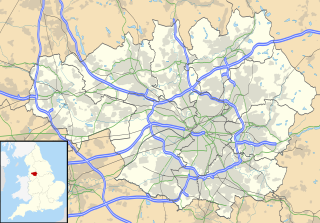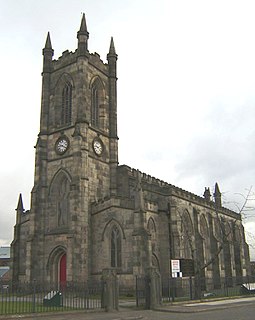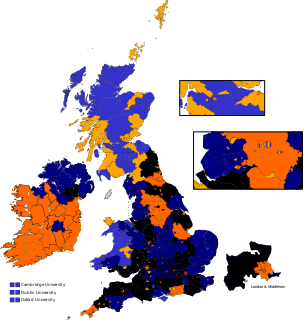Related Research Articles

Manchester is a city and metropolitan borough in Greater Manchester, England. The city has a population of 547,627 and lies within the United Kingdom's second-most populous urban area, with a population of 2.7 million and third-most populous metropolitan area, with a population of 3.3 million. It is fringed by the Cheshire Plain to the south, the Pennines to the north and east, and an arc of towns with which it forms a continuous conurbation. The local authority for the city is Manchester City Council.

Greater Manchester is a metropolitan county and combined authority area in North West England, with a population of 2.8 million; the third largest in England after Greater London and the West Midlands. It encompasses one of the largest metropolitan areas in the United Kingdom and comprises ten metropolitan boroughs: Bolton, Bury, Oldham, Rochdale, Stockport, Tameside, Trafford, Wigan, and the cities of Manchester and Salford. Greater Manchester was created on 1 April 1974, as a result of the Local Government Act 1972, and designated a functional city region on 1 April 2011.

Salford is a city within the City of Salford, Greater Manchester, England. It is directly west of Manchester city centre in a meander of the River Irwell, which forms part of its boundary with Manchester.

Bury is a large market town in Greater Manchester, England, on the River Irwell 5.5 miles (8.9 km) east of Bolton, 5.9 miles (9.5 km) southwest of Rochdale and 7.9 miles (12.7 km) northwest of Manchester. Bury is the administrative centre of the Metropolitan Borough of Bury, and had a population of 78,723 in 2015; the borough had a population of 187,474 in 2011.

The Salford Hundred was one of the subdivisions of the historic county of Lancashire, in Northern England (see:Hundred. Its name alludes to its judicial centre being the township of Salford. It was also known as the Royal Manor of Salford and the Salford wapentake.

Worsley is a town in the City of Salford in Greater Manchester, England, which in 2014 had a population of 10,090. It lies along Worsley Brook, 5.75 miles (9.25 km) west of Manchester. The M60 motorway bisects the area.

The history of Manchester encompasses its change from a minor Lancastrian township into the pre-eminent industrial metropolis of the United Kingdom and the world. Manchester began expanding "at an astonishing rate" around the turn of the 19th century as part of a process of unplanned urbanisation brought on by a boom in textile manufacture during the Industrial Revolution. The transformation took little more than a century.

Harpurhey is an inner-city area of Manchester in North West England, three miles north east of the city centre. Historically in Lancashire, the population at the 2011 census was 17,652.

Gorton is an area of Manchester in North West England, southeast of the city centre. The population at the 2011 census was 36,055. Neighbouring areas include Audenshaw, Denton, Levenshulme, Openshaw, and Reddish.

Swinton is a town within the City of Salford in Greater Manchester, England, southwest of the River Irwell, 3.4 miles (5.5 km) northwest of Salford and 4.2 miles (6.8 km) northwest of Manchester, adjoining the towns of Pendlebury and Clifton. In 2014, it had a population of 22,931.

Greater Manchester Police (GMP) is the territorial police force responsible for law enforcement within the metropolitan county of Greater Manchester in North West England. GMP is the fourth largest police service in the United Kingdom after the Metropolitan Police Service, Police Scotland and Police Service of Northern Ireland (PSNI); and is the second largest force in England and Wales.

Pendleton is an inner city suburb of Salford, Greater Manchester, England, 2 miles (3.2 km) from Manchester city centre. The A6 dual carriageway skirts the east of the district.
Manchester and Salford Police was a police force in England from 1 June 1968 to 31 March 1974. It was created as a merger of the Manchester City Police and Salford City Police and covered the adjacent county boroughs of Manchester and Salford. It was amalgamated with parts of the Lancashire Constabulary and Cheshire Constabulary under the Local Government Act 1972 to form Greater Manchester Police.

The School of Medical Sciences at the University of Manchester is one of the largest in the United Kingdom with around 6,000 undergraduates, 3,000 postgraduates and 2,000 staff. It is the third oldest medical school in England and the largest medical school in the United Kingdom. The Faculty is a member of the Manchester Academic Health Science Centre and has four affiliated teaching hospitals at Manchester Royal Infirmary, Wythenshawe Hospital, Salford Royal Hospital and the Royal Preston Hospital.

South Lancashire, formally called the Southern Division of Lancashire or Lancashire Southern, is a former county constituency of the South Lancashire area in England. It returned two Members of Parliament (MPs) to the British House of Commons from 1832 to 1861, and then from a very narrow reform of that year, three until it was further split in 1868.

Little Hulton is an area within the City of Salford, Greater Manchester, England, 3.4 miles (5.5 km) south of Bolton, 7 miles (11.3 km) west-northwest of Salford, and 9 miles (14.5 km) west-northwest of Manchester. Little Hulton is bordered by Farnworth to the north and Walkden to the east.

Sir Elkanah Armitage DL was a British industrialist and Liberal politician.

The following is a timeline of the history of the city of Manchester in north west England.
Thomas Heywood (1797–1866) was an English antiquarian. He was closely involved in the Chetham Society and its publications.
Nesta Helen Wells was a British physician, and police surgeon. When she was appointed in 1927, she was the first female police surgeon in the United Kingdom.
References
- ↑ Manchester obtained city status in the United Kingdom in 1853
- ↑ Frangopulo, N. J., ed. (1962) Rich Inheritance. Manchester: Education Committee; p. 276
- ↑ Sir Robert Peacock
- ↑ "Wells [née Perry], Nesta Helen". Oxford Dictionary of National Biography (online ed.). Oxford University Press. doi:10.1093/ref:odnb/58141.(Subscription or UK public library membership required.)